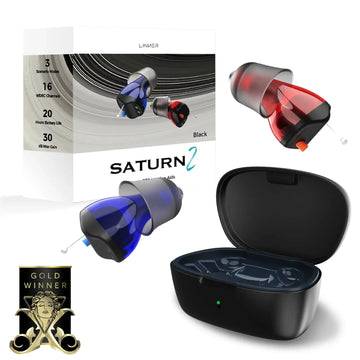By: Ashley Tilahun, Au.D., CCC-A., FAAA
Individuals experiencing hearing loss may face daily life challenges such as difficulty understanding speech in one-on-one or group conversions, experiencing isolation at times due to background noise interfering with speech clarity, challenges with enjoying music, and an increased risk of decline mentally, emotionally, cognitively, and overall well-being.
For most folks with progressive or even sudden hearing loss, it can become a battle to determine whether it's better to wear one or two hearing devices in order to hear better daily. This can be a very pivotal decision. Linner OTC hearing aids have provided viable options for those looking to tackle their auditory challenges.
It is important to understand the advantages and benefits of using bilateral hearing aids, as well as when it is acceptable only to utilize one device. Read on to learn more about the valuable insights into the advantages of this approach and how Linner's innovative devices can offer valuable support in providing auditory enhancement.
The advantages of utilizing Dual Hearing Devices are:
- Prevention of auditory deprivation
- Brain stimulation and cognitive Health
- Superior sound quality and speech clarity
- Improved sound localization
- Enhanced auditory perception and processing
- One hearing aid is still better than none
Let’s go into a bit of detail for further understanding with basic examples given:
Advantages of Using Two Hearing Aids:
1. Prevention of Auditory Deprivation
When there is a lack of auditory stimulation, this could increase the risk of auditory deprivation, hence the importance of wearing bilateral hearing devices.
Studies published in the Journal of the American Academy of Audiology highlighted the decline in word recognition understanding abilities in individuals using one hearing device versus two hearing devices.
For example, if you only use one hearing aid or none at all, your hearing might get worse over time, and part of your auditory nerves and brain may atrophy, like a muscle that weakens if not used. Therefore, utilizing two hearing aids keeps both ears active and healthy, helping you recognize words and sounds better.
2. Brain Stimulation and Cognitive Health
As mentioned before, if hearing loss goes untreated, or if there is a lack of auditory stimulation, it may lead to brain atrophy, which in turn could lead to increasing the risk of cognitive decline and conditions like dementia. The National Institute on Deafness and Other Communication Disorders (NIDCD) stresses the importance of auditory stimulation for maintaining cognitive health.
Today’s hearing devices may contribute to this aspect by offering sophisticated features that go beyond basic amplification. These devices engage the brain with clear sounds, fostering continuous stimulation and potentially reducing the risk of cognitive decline.
Just keep in mind that when you’re not using hearing aids when you need them, it can lead to problems with brain health, similar to not exercising your body. Using hearing aids is like giving your brain a healthy workout with sounds, which may help keep your mind sharp.
3. Superior Sound Quality and Speech Clarity
The allure of bilateral hearing aids extends to the realm of superior sound quality across diverse auditory stimuli.
Modern hearing aids and hearing devices are designed to provide enhanced sound clarity, particularly when listening to music or television, when listening to speech in quiet or noisy environments, and to have an auditory awareness of everyday sounds.
Just think: using two good-quality hearing aids makes sounds and speech clearer and more natural. It’s like hearing the difference between a fuzzy old TV and a new high-definition one. Bilateral hearing aids may help with speech understanding better in both quiet and noisy places.
4. Improved Sound Localization
A significant benefit of wearing two hearing devices is enhanced spatial awareness. By utilizing two hearing aids this may enhance sound localization for improved safety and situational awareness.
Current hearing devices, with their state-of-the-art directional microphones and spatial processing capabilities, may excel in offering hearing aid users an improved ability to identify sound sources accurately.
Whether it's a distant siren or someone calling from another room, most hearing devices may help contribute to an increased sense of sound localization.
Consider this: wearing two hearing aids helps you figure out where sounds are coming from, like knowing if a car is approaching from the left or right. Utilizing two hearing aids is essential for safety and understanding your surroundings.
5. Enhanced Auditory Perception and Processing
It is important to wear hearing aids as they help amplify the auditory reception. According to one of the articles about auditory perception and processing from the American Speech-Language-Hearing Association (ASHA), it was emphasized that the brain has the ability to process information better and clearer when stimulated by both ears.
Modern hearing devices equipped with advanced technology, optimized sound processing, and strategic placement of microphones and sophisticated algorithms work together to enhance the brain’s ability to perceive and process sound effectively, as well as provide users with an unparalleled auditory experience.
Simply put, wearing two hearing aids is like your brain is using both ears to listen rather than just one. Think mono sound versus stereo surround sound. Hearing aids may help your brain hear and understand speech and environmental sounds better, very similar to using two eyes to see everything around you better than just one eye. Modern hearing aids are like high-tech helpers that make sounds clearer and easier for your brain to understand.
6. When Is One Hearing Aid Acceptable?
While the advantages of bilateral hearables and hearing aids are apparent, of course, there are some exceptions to this. It is acceptable to use one hearing aid if an individual has one normal hearing ear or if an individual finds wearing two hearing devices too overwhelming.
Most hearing products, with their adaptable settings and user-friendly controls, cater to individual preferences. They offer flexibility for users who may initially find dual devices challenging, allowing for a gradual adjustment to the enhanced auditory experience.
Just know that it's okay to use just one hearing aid, like if your other ear hears perfectly or if you find using two too difficult at first. Many hearing aids have settings that can be adjusted to make it easier for you to get used to them. Also, wearing one hearing aid is certainly better than none at all! It is definitely better to hear as much as possible than to not hear very much and be overly frustrated.
Holistic Approach with Linner OTC Hearing Aids:
It is important to take advantage of the benefits of bilateral hearing aid use, and certainly with the use of Linner OTC Hearing Aid capabilities, which offers a holistic approach to improving hearing.
Utilizing advanced technologies such as Linner OTC Hearing aids may help with comprehensive and personalized solutions, especially with the use of bilateral Linner hearing products.
The benefits of bilateral Linner OTC Hearing Aids:
- Advancements in technology
- Enhancing the quality of life
- Affordable
- Improved cognitive health
Advancements in technology have significantly improved the role of hearing devices in enhancing and improving the quality of life for those with hearing loss.
Whether opting for high-priced traditional hearing aids or exploring affordable, innovative solutions like Linner's, the goal remains consistent: providing a seamless auditory experience for better communication, cognitive health, and overall well-being.
A comprehensive assessment by a hearing professional, combined with tailored consultation by a Linner hearing professional on hearing aid and hearing device solutions, marks the first step toward better and improved auditory experiences. Understanding the advantages, especially those offered by Linner OTC hearing aids, empowers individuals to make informed choices that enhance their hearing and overall quality of life.
References:
- American Speech-Language-Hearing Association (ASHA) - Information on bilateral hearing and auditory processing.
- Reference link: [ASHA - Bilateral Hearing and Auditory Processing] https://www.asha.org/public/hearing/bilateral-hearing-and-auditory-processing/
- Journal of the American Academy of Audiology - Studies emphasizing the benefits of dual hearing aids.
- Reference link: [Journal of the American Academy of Audiology] https://www.audiology.org/publications/journals
- National Institute on Deafness and Other Communication Disorders (NIDCD) - Research on hearing loss and cognitive decline.
- Reference link: [NIDCD - Hearing Loss and Cognitive Decline
https://www.nidcd.nih.gov/health/hearing-loss-and-cognitive-decline
- Linner Hearing Devices - Information on the technology and features provided by Linner in their hearing devices.
- Reference link: [Linner Hearing Devices Official Website] https://www.linner.co/
- Middlebrooks JC. Sound localization. Handb Clin Neurol. 2015;129:99-116. doi: 10.1016/B978-0-444-62630-1.00006-8. PMID: 25726265.
- Reference link: [Handbook of Clinical Neurology] https://pubmed.ncbi.nlm.nih.gov/25726265/


![Linner Mercury Clarity OTC Hearing Aids [FSA & HSA Eligible] Linner](http://www.linnerlife.com/cdn/shop/files/Linner-Mercury-Clarity-OTC-Hearing-Aids-_FSA-_-HSA-Eligible_-Linner-110038953.webp?v=1725853434&width=360)

![Linner Mars OTC Hearing Aids [FSA & HSA Eligible] Linner](http://www.linnerlife.com/cdn/shop/files/Linner-Mars-OTC-Hearing-Aids-_FSA-_-HSA-Eligible_-Linner-110039213.webp?v=1725865495&width=360)
